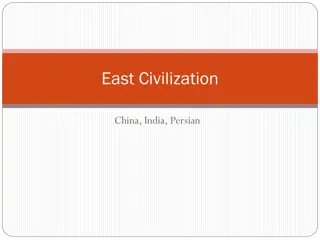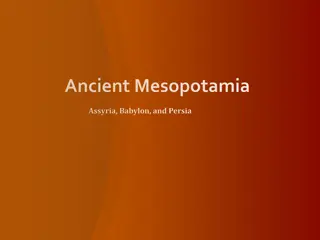
Classical Civilizations: Empires, Propaganda, and Conquest
Explore the strategies and conquests of the Assyrians in ancient times, including their psychological warfare tactics, takeover of Babylon, and conflicts with Judean kingdoms. Uncover the power dynamics and propaganda of Classical Civilizations that shaped the world through empire-building.
Uploaded on | 0 Views
Download Presentation

Please find below an Image/Link to download the presentation.
The content on the website is provided AS IS for your information and personal use only. It may not be sold, licensed, or shared on other websites without obtaining consent from the author. If you encounter any issues during the download, it is possible that the publisher has removed the file from their server.
You are allowed to download the files provided on this website for personal or commercial use, subject to the condition that they are used lawfully. All files are the property of their respective owners.
The content on the website is provided AS IS for your information and personal use only. It may not be sold, licensed, or shared on other websites without obtaining consent from the author.
E N D
Presentation Transcript
Welcome to Unit II The Classical Civilizations When Empire and Propaganda changed the world.
Assyrian hostel takeover of Babylon The Assyrian strategy for conquest depended heavily on psychological warfare. They would first send their "cup-bearers the representatives of the king to try and persuade a city to surrender without a fight. If this failed, the Assyrian army would then surround the city and shout at the defenders, trying to convince them that resistance was useless. Woe to the people who still refused to capitulate, for if forced to fight, the Assyrians would then bring out their giant wheeled siege towers and enormous armored battering rams to breach the city walls.
In 721 BCE, the Assyrian army captured the Israelite capital at Samaria and carried away the citizens of the northern kingdom into captivity. The virtual destruction of Israel left the southern kingdom, Judah, o fend for itself in the whirlwind of warring Near Eastern kingdoms. At the time of Samaria's fall, there existed two kings in Judah Ahaz and his son Hezekiah who ruled as co-regents. Judah existed as a vassal to Assyria during this time and was forced to pay an annual tribute to the powerful empire.In 715 BCE, following the death of Ahaz, Hezekiah became the sole regent of Judah and initiated widespreadreligious changes, including the breaking of religious idols. He re-captured Philistine-occupied lands in the Negev desert, formed alliances with Ashkelon and Egypt, and made a stand against Assyria by refusing to pay tribute. In response, Sennacherib attacked Judah, laying siege on Jerusalem.
Column I Sennacherib, the great king, the mighty king, king of the universe, king of Assyria, king of the four quarters (of the earth); the wise ruler (lit. shepherd, "pastor"), favorite of the great gods, guardian of the right, lover of justice; who lends support, who comes to the aid of the needy, who turns (his thoughts) to pious deeds; perfect hero, mighty man; first among all princes, the powerful one who consumes the insubmissive, who strikes the wicked with the thunderbolt; the god Assur, the great mountain, an unrivaled kingship has entrusted to me, and above all those who dwell in palaces, has made powerful my weapons; from the upper sea of the setting sun to the lower sea of the rising sun, all humankind (the black-headed race) he has brought in submission at my feet and mighty kings feared my warfare Column 4 I slew the governors and nobles who had committed sin (that is, rebelled), and hung their bodies on stakes around the city. The citizens who sinned and treated (Assyria) lightly, I counted as spoil. Padi, their king, I brought out of Jerusalem, set him on the royal throne over them and imposed upon him my kingly tribute. As for Hezekiah, the Jew, who did not submit to my yoke, 46 of his strong, walled cities, as well as the small cities in their neighborhood, which were without number,-by levelling with battering-rams and by bringing up siege-engines, by attacking and storming on foot, by mines, tunnels and breaches, I besieged and took (those cities). 200,150 people, great and small, male and female, horses, mules, asses, camels, cattle and sheep, without number, I brought away from them and counted as spoil. Himself, like a caged bird I shut up in Jerusalem his royal city.
Assyrian Empire 700 BCE - 612 BCE The Assyrians Take over the Babylonians
Nebuchadnezzar 612 BCE Nebuchadnezzar treacherously massacred the king. He then carried away into captivity 5,000 Judeans and 7,000 from the other tribes, including all the nobles and scholars of the city.
Although The Babylonians reclaim their land from the Assyrians, their glory did not last long, The Persians captured Babylon in 539 BCE, when Cyrus was welcomed into Babylonian cities. Nebuchadnezzer Recaptured the great city.
Cyrus the Great (532 BCE) Cambyses (son of Cyrus) Darius (followed Cambyses)- set up satrap
Political Structure of the Persian Empire Ruled by a King - 20 satrapies (provinces) ruled by the satraps (governors) - Each satrap reported back to the king - anyone could live within the empire as long as you paid taxes to the empire - Cyrus (559 - 530 BCE) AKA Cyrus the Great to the Jews - His treatment of Babylonia showed a great deal of restraint and wisdom. He demonstrated compassion in his conquest and organization of his empire. He was merciful. - Darius (521 - 486 BCE) AKA Grandson of Cyrus
Advanced Technology -Well maintained roads - which provided food, shelter and fresh horses along the way - The Royal Road (from Lydia to Susa) - used for trade and travel Religion - Zoroastrianism (Monotheistic) Holy Book = Zend Avesta Zoroaster born in 660 BC revered as a prophet of Ahuramazda (creator of all things, the wise lord, supreme God). He did not go unopposed, the evil spirit Ahrima opposed him. Ahuramazda gave humans the freedom to choses between right and wrong. The good person will Chose the right way.





















